
The Caribbean Islands, 1715: Blood on the water. The black flag flies proudly as pirates plunder and pillage the high seas seemingly without consequence, bringing world empires to their knees. Adventurers and swashbucklers from all over the world flock to the islands eager to pursue their fortunes. Among these maritime raiders came three of the most notorious pirates to ever sail the seven seas: the brutish Charles Vane, the wild and clever “Calico” Jack Rackham, and the terror of the Caribbean himself, Edward Thatch, known endearingly among his fellow plunderers as Blackbeard. What these men desire most is fortune and glory…but their unquenchable thirst for gold and silver would eventually prove to be their downfall.
To understand the origins of our troublesome trio of pirates, our story will begin following the events of the Spanish War of the Succession. England and Spain had just emerged from a particularly disastrous conflict, in which colonial land was conquered, surrendered, conquered, and surrendered again in an endless cycle of destruction.1 During the war, a Spanish fleet seized the British Caribbean island of Nassau, hoping to teach the British a firm lesson in violence. In the year 1703, in a series of catastrophic events, the Spaniards plundered the island of its riches, slaughtered its inhabitants, and razed it to the ground. The once tropical paradise had been reduced to a mere pile of ash, left utterly abandoned of its life and settlers. Seeing that preserving Nassau as a colonial province was a lost cause, England withdrew all presence from New Providence Island and left it to rot as a backwater, shoddy outpost of disease and filth.2
Years passed, and Nassau remained empty. With the signing of the Peace of Utrecht between Britain and Spain in 1713, English privateers found themselves unemployed; many decided to abandon their careers and resort to piracy.3 Following the Spanish war, rumors of an unoccupied island, free of British control, started to spread all across the Caribbean. Around 1713, Captain Benjamin Hornigold, a veteran of the Spanish War himself, settled on the island with a ragtag band of former privateers. With him was a young Edward Thatch, whom Hornigold would take as an apprentice and introduce to a life of piracy.4 Drunkards, tradesmen, merchants, and pirates alike began to flock to Nassau; its utopian appeal attracted other famed seafaring marauders, such as the wealthy planter-turned-pirate Stede Bonnet, the female pirates Anne Bonny and Mary Reade, and Sam Bellamy, among others. Among the new wave of arrivals between 1716 and 1717 was an ambitious English captain, Charles Vane, and his cunning first mate, Jack Rackham.5 Many other pirates continued to discover a safe haven on Nassau; however, none stood out more than the terrifying trio themselves. Combined with the mentorship of Benjamin Hornigold, the brutality of Vane and Blackbeard, and the cleverness of Rackham, the pirates of Nassau came together and declared war: not only on England, but on all civilization.
As the number of pirates on Nassau increased, it was time to get busy. At the suggestion of Captain Hornigold and Blackbeard, the pirates agreed to fortify Nassau’s old British defenses to prevent against incursions by fellow pirates and the English Crown alike. The leading council of pirates, consisting of Hornigold, Blackbeard, Rackham, and Vane, established a makeshift, yet somewhat efficient, Republic. Though there seems to be a lack of evidence to suggest that they had a clear set of laws, their word was respected all throughout New Providence Island.6
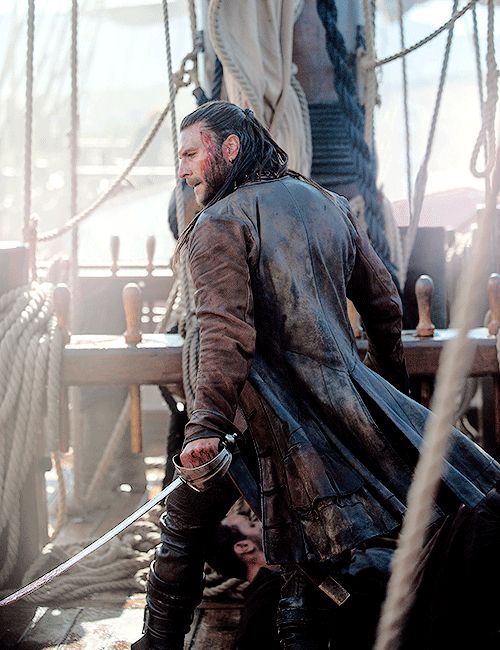
Blackbeard, Vane, and Rackham did most of the dirty work when it came to plundering. Together, they began to seize prizes on the high seas, capturing merchant ships and sinking British vessels left and right. With hulls full of plunder and booty, Blackbeard and Vane decided to take it a step further, embarking beyond Nassau’s waters—and they began to terrorize the Atlantic coast. With his trusty brig The Ranger, and Jack Rackham as his second, Charles Vane went on a rampage, plundering the waters spanning from the Caribbean to as far north as the New York coast. He was known for his cruelty towards his captives, punishing and torturing them in sadistic methods. One of Vane’s notable prizes was a Bermudan merchant vessel, known as the Diamond, which was traversing the waters surrounding the Bahamas at the time of its capture. Vane’s crew overcame the ship swiftly, and with exceptional brutality. In a testimony given to the governor of Bermuda, one survivor alleged that Vane had tortured him with a cutlass, then hung him. Furthermore, the captain of another Bermudan vessel, the William and Martha, attested that Vane had humiliated the merchant crew with severe beatings and torture methods, including burning them with lit matches. Vane was fond of a particular form of torture and execution known as keelhauling, in which the victim was tied up with a rope, thrown overboard, and dragged from one side of the ship to the other. The victim would be forced to endure an unimaginable amount of pain, often to the point of bleeding out, in which the barnacles attached to the ship’s hull would inflict punishing lacerations to their bare skin.7
Contrary to the attitudes of his captain, Rackham was the quietest of the trio, preferring the art of plotting and planning from the shadows rather than cruelty and brute force. As the Ranger’s first mate and quartermaster, he was charged with managing the crew and keeping order aboard at all times. He followed Vane on every heist, lending a calming ear to his captain when he could. Rackham and Vane had a love-hate relationship; although the two often disagreed, together, they were an unstoppable force of pirate might. Rackham had the brains, and Vane had the brawn. Besides being incredibly cunning, Rackham was also a womanizer; between the years 1718 and 1719, Rackham recruited a female pirate, Anne Bonny, to the crew. The couple became lovers, and for the rest of Rackham’s pirating career, they would never leave each other’s side. Much to the annoyance of Charles Vane, Jack’s charisma, cleverness, and romantic nature found favor among the crew, who were growing increasingly weary of the captain’s cruel demeanor. Rackham is credited with pioneering the design of the Jolly Roger, the black flag emblazoned with a skull and crossed swords that signaled impending death upon all who saw it.8
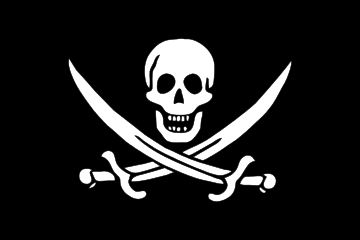
In 1717, Blackbeard’s campaign extended its terrifying reach from the waters of Chesapeake Bay to Philadelphia and the upper eastern coast, as he traveled back and forth between northern and Caribbean waters. Blackbeard’s plundering would not have been possible without his prized frigate, the Queen Anne’s Revenge. Formerly a French slave ship known as La Concorde, she boasted a massive broadside of French and English cannons, and was known for her impressive sailing speed. Just on his Atlantic campaign alone, Blackbeard captured fifteen ships within a span of a few weeks, which was a great accomplishment for even the most skilled pirates. Blackbeard’s notoriety allowed him to amass a small pirate fleet, which included Stede Bonnet and his own brig, the Revenge.9 Vessel after vessel fell victim to Blackbeard and his cohorts, all the while the elusive captain evaded capture by the Royal Navy. Blackbeard’s greatest and most daring feat, however, was the infamous blockade of Charleston, in which he and his fleet laid siege to the Charleston harbor for six days, sinking or capturing any merchant vessels that dared to pass by. Blackbeard held his unfortunate prey of captured crewmen for ransom, vowing not to end his blockade until Charleston agreed to pay him in medicines to treat syphilis. Eyewitness testimony from his captives attested that Blackbeard oftentimes did not plunder for resources, but simply just to delight in destruction—in which he leveled entire coastal settlements and sank or burned merchant ships without cause. Accounts within A General History Of The Pirates allege that Blackbeard was a fearsome fighter, armed with a bandolier of flintlock pistols; apparently, Blackbeard would also tie lit fuses to the bottom of his captain’s hat to make him appear more devilish in battle.10
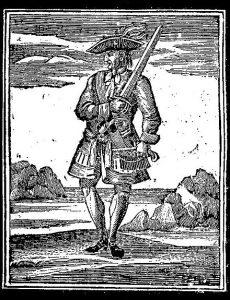
Despite the temporary success of the pirates, a new arrival had thrown Nassau into despair. While Blackbeard was taking a temporary vacation from piracy off the North Carolina coast, Vane returned to Nassau to flaunt his prizes. Little did he know, however, that Nassau was about to be changed forever. Observing that the piracy problem in the Caribbean and the Atlantic coast was out of control, King George I appointed Woodes Rogers as governor of New Providence Island. The King gave the pirates an ultimatum: to take a royal pardon and live their lives as penniless, but free men, or to die as pirates either by the sword or by the noose. By the year 1718, Rogers had arrived to Nassau with an English fleet, promises of civilization, and a full list of pardons. Captain Hornigold, the once proud mentor of pirates far and wide, took the pardon and agreed to hunt down his former associates.11 Jack Rackham, in an effort to secure his own life and that of his swashbuckling lover, Anne Bonny, agreed to the pardon. Vane and Blackbeard, however, were not amused by the governor’s antics. Vane openly refused the pardon, and in an incredible display of pirate heroism, launched a fireship into the governor’s blockade, and ordered the Ranger to fire its cannons on Rogers’ flagship.12 In the confusion, Vane successfully escaped Nassau; and Blackbeard continued his pirate rampage across the Atlantic.
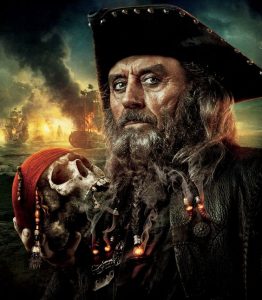
The die had been cast; the pirates had played their cards, and it was up to Governor Rogers to make the next move. Rogers was determined to end the scourge of piracy once and for all, and he enlisted the help of eager pirate hunters from all across the British Empire. Blackbeard and Vane had made no friends across the high seas during their years of raiding and plundering; indeed, there was no shortage of those who wanted to see their destructive campaigns come to a swift end. At some point in 1718, Vane was deposed as captain of the Ranger. His cruel methods were not appreciated by his crew, who viewed him as a greedy and tyrannical leader. The crew conducted a mutiny and voted in Rackham as captain. As a result, Vane was marooned on a desert island off the coast of Honduras, where he eventually found refuge on a passing merchant vessel. Unfortunately, the ship’s captain recognized Vane, and turned him over to British authorities. In 1720, he was tried in Port Royal, Jamaica, and found guilty of piracy. Vane was executed the following year.13
Rackham eventually abandoned the governor’s pardon and returned to piracy. He proved to be an efficient leader, but his captaincy was short lived. In 1720, Rackham was captured by pirate hunters and imprisoned in Port Royal. He pleaded his innocence on all four counts of piracy, but his testimony proved futile. Rackham ultimately suffered the same fate as Charles Vane—he too was executed, and his body was hung to rot in a gibbet outside of Port Royal’s harbor.14 Blackbeard fell in battle during a naval skirmish with British troops off the mainland of Ocracoke. In a surprise attack, he was overcome by the combined forces of British Lieutenants Alexander Spotswood and Robert Maynard. Although his crew managed to put up a great fight and killed a significant amount of British soldiers, the fearsome captain met his end aboard the enemy’s ship. Blackbeard’s body was dumped into the sea, and his head was allegedly granted as a trophy to Spotswood.15
With the death of the last great Caribbean pirates, the Golden Age of Piracy had come to a close. Small pockets of pirates still remained throughout the Bahamas, but none ever rose to the infamy of Nassau’s formidable trio of marauders. In the end, civilization proved to be stronger than the pirates; under the careful eye of Governor Rogers, the once wild and free island was tamed, finally welcomed once again with open arms into the embrace of the British Empire. The pirate’s life slowly drifted away, into the annals of history; it was now nothing more than a fantasy, a long lost dream of aspiring adventurers and daredevils. The Golden Age of Piracy may have come to an end, but it remained forever burnt into the minds of those who experienced it.
- James A Ogilvy, “War of the Spanish Succession, The Canadian Encyclopedia,” The Canadian Encyclopedia, accessed October 1, 2021, https://www.thecanadianencyclopedia.ca/en/article/war-of-the-spanish-succession. ↵
- Aaron Higgins, “The Republic of Pirates,” Nassau in the Atlantic World (blog), accessed September 27, 2021, http://aaronhiggins.blogs.wm.edu/the-republic-of-pirates/. ↵
- Toby Arguello, “Nassau’s Pirates: Revealing the Sordid History of the Bahamian Port City,” Explore the Archive (website), July 15, 2020, https://explorethearchive.com/nassau-pirates-history. ↵
- The Legends of History, Benjamin Hornigold: The Man Who Trained Blackbeard (Pirate History Explained), 2018, https://www.youtube.com/watch?v=GxJep2rzo3Y. ↵
- Mark Cartwright, “Charles Vane,” World History Encyclopedia, accessed September 27, 2021, https://www.worldhistory.org/Charles_Vane/. ↵
- Aaron Higgins, “The Republic of Pirates,” Nassau in the Atlantic World (blog), accessed September 27, 2021, http://aaronhiggins.blogs.wm.edu/the-republic-of-pirates/. ↵
- Mark Cartwright, “Charles Vane,” World History Encyclopedia, accessed September 27, 2021, https://www.worldhistory.org/Charles_Vane/. ↵
- Mark Cartwright, “Calico Jack,” World History Encyclopedia, accessed September 27, 2021, https://www.worldhistory.org/Calico_Jack/. ↵
- Toby Arguello, “Nassau’s Pirates: Revealing the Sordid History of the Bahamian Port City,” Explore the Archive (website), July 15, 2020, https://explorethearchive.com/nassau-pirates-history. ↵
- Colin Woodard, “The Last Days of Blackbeard,” The Smithsonian (website), accessed September 27, 2021, https://www.smithsonianmag.com/history/last-days-blackbeard-180949440/. ↵
- Aaron Higgins, “The Republic of Pirates,” Nassau in the Atlantic World (blog), accessed September 27, 2021, http://aaronhiggins.blogs.wm.edu/the-republic-of-pirates/. ↵
- Mark Cartwright, “Charles Vane,” World History Encyclopedia, accessed September 27, 2021, https://www.worldhistory.org/Charles_Vane/. ↵
- Colin Woodard, “The Last Days of Blackbeard,” The Smithsonian Magazine (website), accessed September 27, 2021, https://www.smithsonianmag.com/history/last-days-blackbeard-180949440/. ↵
- Mark Cartwright, “Calico Jack,” World History Encyclopedia, accessed September 27, 2021, https://www.worldhistory.org/Calico_Jack/. ↵
- Colin Woodard, “The Last Days of Blackbeard,” The Smithsonian Magazine (website), accessed September 27, 2021, https://www.smithsonianmag.com/history/last-days-blackbeard-180949440/. ↵
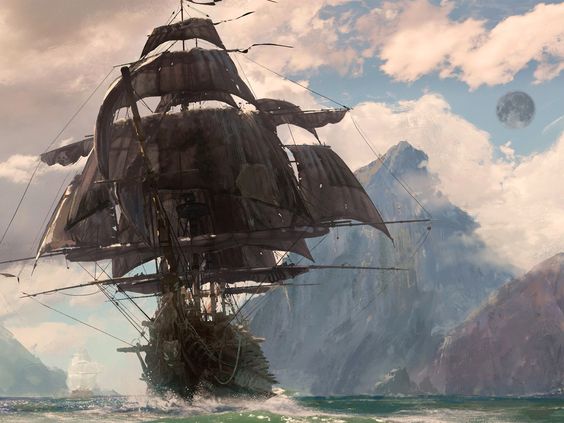



61 comments
Travis Green
What a great and informative article about a subject I didn’t know much about before I read this article. I like how you made this article entertaining as well as informative. You made me learn a lot more about the golden age of piracy as a result for example I never would have known that Captain Hornigold basically betrayed the rest of the pirates after accepting the British’s deal and helping to hunt down the rest of the pirates.
Kensley Dieckow
I really liked how you told the whole story from their successes down to their demise. Its really interesting to know how the pioneers of piracy were persecuted and even gave the option of a pardon considering how brutal they were. I also really like that you included information on their personality and how they even struggled with what each other were doing.
Andrea Ramirez
What a Wonderful Article, Elliot.
I really enjoy reading this article. I liked that you kept the story very entertaining and, most important, real at all times. The article was very clear, understandable and therefore, easy to read. I did not know how influential the pirates were in history, if I even knew that The Golden Age of Piracy existed.
Likewise, I liked that you added images of the characters, as well as the logo of “Jolly Roger”, because that really gave more life to history and allowed me to visualize the content better.
Honestly, I want to congratulate you because the prize is well deserved.
Antonika Vainqueur
This article was a great read. The introduction along with the title instantly hooks the reader, piquing the interest in the writing. The background information was engaging, especially with a topic wildly popular. Also, the selection of imagery added to the reader’s vivid imagination of the story. The article being well cited and written, connected with historical themes discussed in WORLD HISTORY Since 1500 class. The author also did an excellent job of expanding on the promise of the article’s title. Congratulations Elliot on your award in having the best article in the category of “European Studies.” It was well deserved.
Victorianna Mejia
I loved this article! It was well written and kept me engaged the entire time. I love the Pirates of the Caribbean and the storyline that follows them. For some reason, I never put it together that it was related to actual historical events. They mention Port Royal and such and I always believed to be part of an imaginative world. This article is going to convince me to go on a Pirates of the Caribbean binge now.
Madison Goza
I was immediately interested when I saw your article because I had heard of Blackbeard and Calico Jack before, and I enjoyed the opportunity to learn more. It was also interesting to hear about how the pirates transformed Nassau into a pirate republic and how complex the characters of the trio were, those weren’t things I had initially expected. Equally unexpected were the pirate hunters who searched for and apprehended the pirates who didn’t accept Rodgers’ pardon. You had a very distinctive voice while writing this article, one that was descriptive and made me want to keep reading. Your conclusion was very powerful too. Great article!
Andrew Ponce
The article was very well articulated and the author was able not only grasp the reader’s attention by the intro, but was also able to keep the reader engaged throughout the article through the method of adventure story telling. It was interesting to see the way the author tells a story of pirates in the 1700’s and makes it intriguing while still teaching the importance of history. It is good to see that the writer of this article made history fun and amusing for others
Vianne Beltran
Hi Elliot,
I can see why your article won the Research Scholars Award. It was very well written and I made sure to take note of how I could structure my own article. The background info on the Spanish War of Succession was helpful in understanding the motives of the pirates. It made them more interesting and more human-like rather than just legends or villains. It also showed how war can change and start new cultures and societies. Your article inspired me to learn more about these pirates and the historical era in which they thrived.
Paula Ferradas Hiraoka
Starting with the topic, it is not common in the StMU Research Scholars website find this type of articles, so I must congratulate you for being a pioneer on this topic. The title is catchy and played a huge role on deciding what to read. How you manage to summarize all this topic, mentioning certain historical events to put the reader in context, and how you wrote it, it motivated me to keep reading until the end. Congratulations on your award and good job on your article!
Dylan Miller
This is an amazing article! As a kid, I loved Pirates of the Caribbean, and to finally know the true stories that these movies are based on is really exciting! While I understood that pirates were real, I never realized the power they had and the political involvement that was spread amongst them! Without this article, I wouldn’t even know about the golden age of piracy, or that Blackbeard was a real person, but I’m glad that I’m now informed about the true nature of pirates, and I’ll definitely be doing more research on their true history in the future!